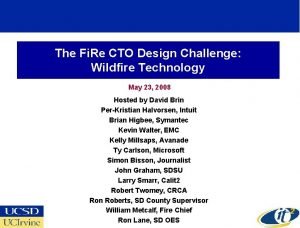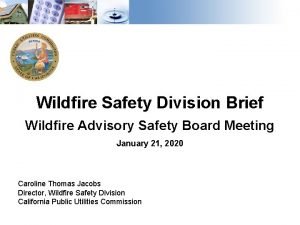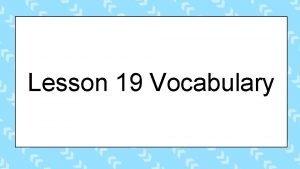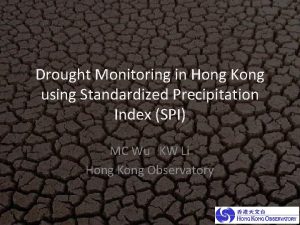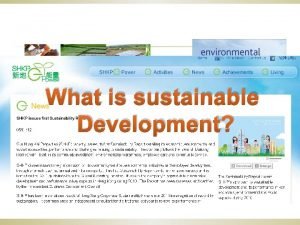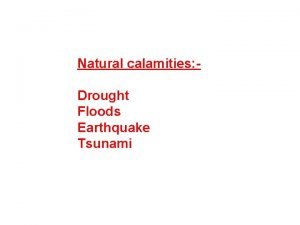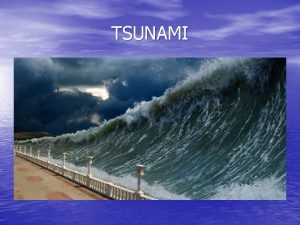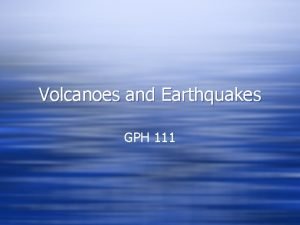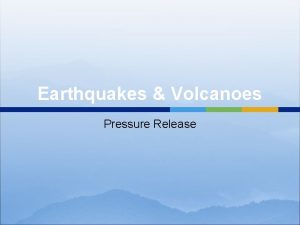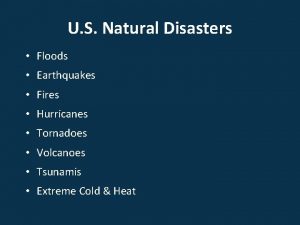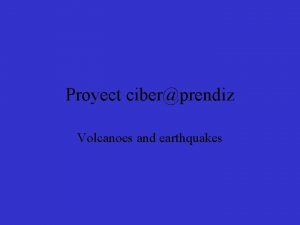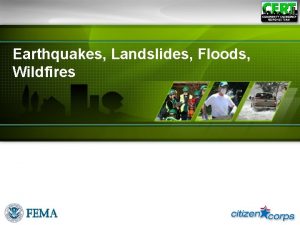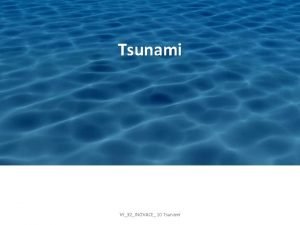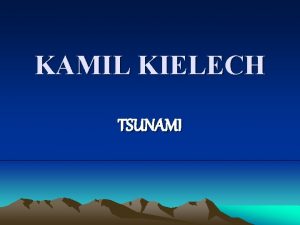Introduction Volcanoes Hurricanes Drought Tsunami Wildfire Earthquakes Floods











- Slides: 11


• • Introduction Volcanoes Hurricanes Drought Tsunami Wildfire Earthquakes Floods

My project is about Natural Disasters. In my project I will explain how and why these happen, the following natural disasters will be the ones in my project: Volcanoes, Hurricanes, Drought, Tsunami, Wildfires, Tornados and Earthquakes. I hope you enjoy it.

What causes volcanoes? Inside the earth's core there is a red-hot liquid rock, called magma. Volcanoes happen when magma rises to the surface of the earth, which causes bubbles of gas to appear in it. This gas can cause pressure to build up in the mountain, and it eventually explodes. When the magma bursts out of the earth, it is called lava. What effects do the volcanoes have? Volcanoes can change the weather. They can cause rain, thunder and lightning. Volcanoes can also have long-term effects on the climate, making the world cooler. Fast-moving lava can kill people and falling ash can make it hard for them to breathe. They can also die from famine, because all their crops have been destroyed animals that have been killed, and earthquakes which can be related to volcanoes. Can we predict when a volcano is going to erupt? Scientists who specialise in volcanoes are called volcanologists. They are getting better at predicting volcanoes. The most reliable method is listening to the 'rumbles' inside a grumbling mountain. They also look at the changes in the gases which come out of volcanic mountains, the angle of the slopes, and bizarrely, the behaviour of animals in the area. Animals often seem to be able to 'detect' when an eruption is coming, and they become agitated and worried.

What is a hurricane ? A hurricane is a huge storm! It can be up to 600 miles across and have strong winds spiralling inward and upward at speeds of 75 to 200 mph. Each hurricane usually lasts for over a week, moving 10 -20 miles per hour over the open ocean. Hurricanes gather heat and energy through contact with warm ocean waters. Evaporation from the seawater increases their power. Hurricanes rotate in a counterclockwise direction around an "eye. " The centre of the storm or "eye" is the calmest part. It has only light winds and fair weather. When they come onto land, the heavy rain, strong winds and large waves can damage buildings, trees and cars. How are hurricanes formed? Hurricanes only form over really warm ocean water of 80 F or warmer. The atmosphere (the air) must cool of very quickly the higher you go. Also, the wind must be blowing in the same direction and at the same speed to force air upward from the ocean surface. Winds flow outward above the storm allowing the air below to rise. What type of seasons do they start in? The Atlantic hurricane season is from June 1 to November 30, but most hurricanes occur during the fall months. The Eastern Pacific hurricane season is from May 15 to November 30.

What is a drought? A drought is simply a long period (usually a season or more) of dry weather where less than normal or no precipitation falls. Precipitation is any form of moisture such as rain, snow, sleet, etc. Droughts are a natural and frequent occurrence in the Delaware River Basin (the basin contains 13, 539 square miles and drains portions of Delaware, New Jersey, New York, and Pennsylvania). How bad a drought is usually depends on how little precipitation falls, how long the drought lasts, and the size of the area that is affected. The next time you hear someone talk about a drought where you live, play detective and look for some of the many signs that may be telling you the lack of precipitation is taking its toll. What effects do droughts have? Droughts can be very dangerous for people in living area where there is not enough water or food. Deaths can happen from lack of food and water, there are lots of health problems too. When there is not enough water, crops fall, which means there isn’t enough food to go around. It also means that the farmers loose a lot of money and that the area can become very poor. When a region is very poor and doesn't have enough food or water, arguments can happen over who should be able to access the goods, which can escalate into wars.

What is a tsunami? A tsunami is a lot of massive waves caused by a disturbance under the ocean e. g. a volcano, an under water earthquake and so on. Tsunamis can move up to 500 miles per hour and can reach up to 100 feet tall. Why are tsunamis caused? A tsunami is caused when there is a disturbance deep under the ocean such as an earthquake, volcano or a landslide. An underwater earthquake is the most common cause for a tsunami, but not just any underwater earthquake causes a tsunami. The earthquake needs to be a large enough earthquake of around 7. 0 magnitude or bigger. If an underwater earthquake is large enough, the ocean floor will make significant movements, therefore the water above the sea floor must move too. The ocean water is pushed upward causing a large ripple that begins to travel through the ocean. This large ripple, which will become the tsunami, travels at a very fast speed of up to 600 miles per hour. Because the ocean is so deep, the wave has plenty of room to move, but when it gets near the shore the wave starts to build in height because the water has nowhere else to travel. Eventually the wave will hit the shore and travel far inland.

What is a wild fire? A wildfire also known as a wild land fire, forest fire, vegetation fire, grass fire, peat fire, bushfire (in Australia), or hill fire is an uncontrolled fire often occurring in wild land areas, but which can also consume houses or agricultural resources. Wildfires often begin unnoticed, but they spread quickly igniting brush, trees and homes. What causes wild fires? Wild fires are caused by human carelessness, lightening, volcano eruptions, arson, heat waves and even drought but 4 out of very 5 wild fires are caused by people.

Earthquakes happen when the moving tectonic plates that make up the surface of the Earth move apart or bump into each other, or slide under each other. This movement tears apart the surface of the Earth, or crunches it up. Most often, this just means a little shaking for a few seconds, and nothing very serious happens. Several times a year, though, somewhere in the world there is enough movement to really shake the earth a lot, and the earthquake is serious enough to knock down buildings. When the buildings fall on people, many people can be killed in a few minutes. The strongest earthquakes can break trees in half.

A flood occurs when water overflows onto land that's normally dry. This can happen in a multitude of ways. Most common is when rivers or streams overflow their banks. Excessive rain, a ruptured dam, rapid ice melting in the mountains, or even an unfortunately placed beaver dam can overwhelm a river and send it spreading over the land beside it, called a floodplain. Coastal flooding occurs when a large storm or tsunami causes the sea to push inland. Most floods take hours or even days to develop, giving residents lots of time to prepare or evacuate. Others generate quickly and with little warning. These flash floods can be extremely dangerous, instantly turning a calmly flowing river into a thundering wall of water and sweeping everything in its path downstream. Moving water has awesome destructive power. When a river overflows its banks or the sea drives inland, structures poorly equipped to withstand the water's strength are no match. Bridges, houses, trees, and cars can be picked up and carried off. The erosive force of moving water can drag dirt from under a building's foundation, causing it to crack and tumble.




